Are tiny bugs buzzing around your fruit bowl or hovering near your kitchen sink? You might be dealing with fruit flies. These common household pests can be a nuisance, but thankfully, eliminating them is easier than you think. You likely have everything you need to create effective fruit fly traps right in your kitchen.
Having recently faced a fruit fly invasion in my own home – a rare occurrence after four years – I took the opportunity to put various elimination methods to the test. Armed with containers and common household items, I experimented with seven different approaches, diligently documenting the results. Today, I’m sharing the most successful DIY fruit fly traps, all crafted from simple, natural ingredients you probably already have. These methods are not only incredibly easy and affordable but also chemical-free. For those who prefer a humane approach, these traps can also be designed to release the captured fruit flies outdoors. Beyond traps, we’ll also explore practical strategies to prevent fruit fly infestations in the first place, ensuring a fruit fly-free kitchen.
Understanding Fruit Flies
Fruit flies are small, winged insects known for their attraction to ripe and fermenting fruits and vegetables – a preference clearly reflected in their name. Beyond fruit, they are also drawn to sugary substances like spilled juice, wine, beer, and even garbage and damp drains where organic matter accumulates. You’ll often find them congregating around fruit bowls, trash cans, and kitchen sinks. Visually, they are tiny, typically about the size of a grain of rice, and resemble small houseflies, with a tan or brownish body and distinctive red eyes. Fruit flies are most prevalent during the warmer months of summer and late fall, coinciding with fruit harvesting seasons.
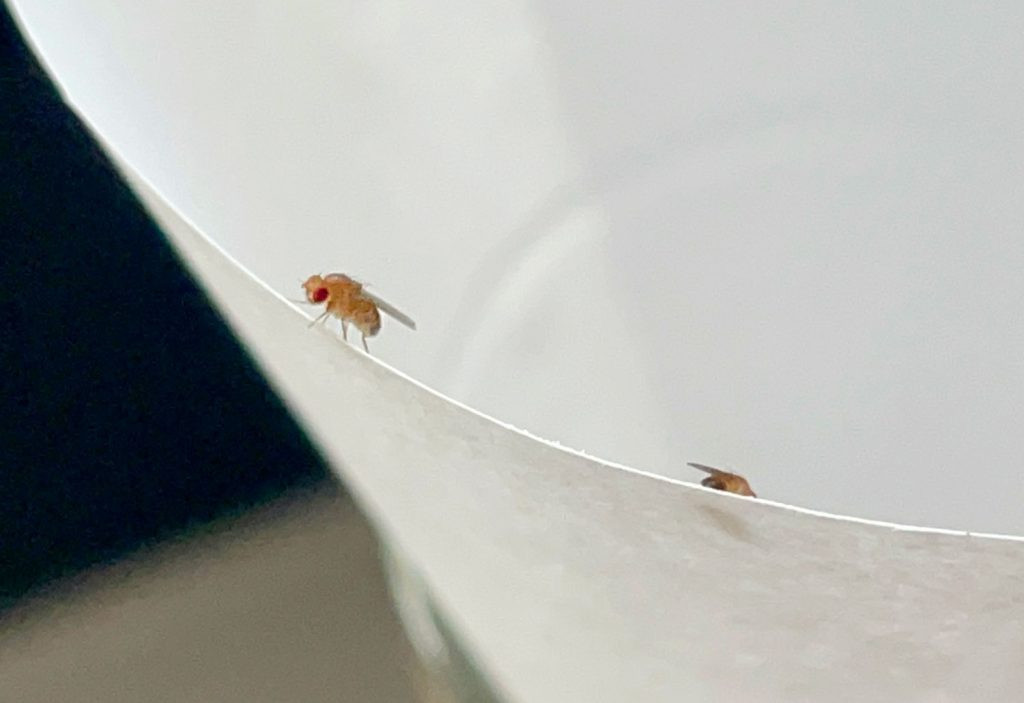 Close Up Of Fruit Fly On Paper Funnel
Close Up Of Fruit Fly On Paper Funnel
Alt text: A detailed close-up photograph showing a fruit fly perched on the edge of a brown paper funnel, illustrating the small size and characteristic red eyes of the insect in a DIY trap.
A fruit fly problem often starts subtly, perhaps with a few stray insects brought indoors on fruits or vegetables from the grocery store or garden. However, female fruit flies are prolific breeders, capable of laying hundreds of eggs in their short lifespan, with eggs hatching in as little as 12 hours. These larvae mature into adults within days, meaning a small initial presence can quickly escalate into a full-blown infestation. This rapid reproduction cycle underscores the importance of acting quickly to eliminate fruit flies as soon as you notice them.
Differentiating Fruit Flies from Similar Pests: Fungus Gnats and Drain Flies
It’s easy to mistake fruit flies for other small flying insects commonly found indoors, particularly fungus gnats and drain flies. While all are small and winged, accurate identification is crucial for choosing the most effective elimination strategy. The easiest way to tell them apart is by observing where you see them and what larger insect they resemble.
- Fruit Flies: These resemble miniature common houseflies. They are typically found near fruit bowls, garbage disposals, compost bins, or any exposed fermenting food sources.
- Drain Flies: These have a fuzzier appearance, resembling tiny moths more than flies. As their name suggests, they are usually seen around sinks, drains, and damp areas, often in bathrooms and kitchens.
- Fungus Gnats: These insects look more like small mosquitoes with longer legs and darker bodies. They are typically associated with houseplants, as they thrive in damp potting soil and feed on fungus in the soil.
If you’re uncertain about the type of pest you’re dealing with, testing one of the traps described below can help. If the trap attracts the insects, you’ll know you’re dealing with fruit flies.
Four Simple DIY Fruit Fly Trap Recipes
Getting rid of fruit flies doesn’t require expensive products or complicated procedures. With just a few common household items and a bit of patience, you can create effective traps. The basic principle behind each trap is to lure the fruit flies in and prevent their escape. I tested four distinct DIY methods and found a clear winner, but since each utilizes readily available materials, experimenting with multiple types is easy and worthwhile. Consider it a fun, impromptu science experiment in your own kitchen! Here are four homemade fruit fly trap methods I personally tested:
- Funnel Trap
- Plastic Wrap Trap
- Dish Soap Trap
- Rotting Fruit Trap
Let’s delve into the specifics of each method, including step-by-step instructions and my findings on their effectiveness. Keep in mind that some traps work faster than others, and it may take several days to completely resolve your fruit fly problem, regardless of the technique you choose.
1. The Paper Funnel Fruit Fly Trap
This trap design utilizes a paper funnel to guide fruit flies into a container baited with an attractant. The narrow opening at the bottom of the funnel makes it easy for flies to enter but difficult to exit.
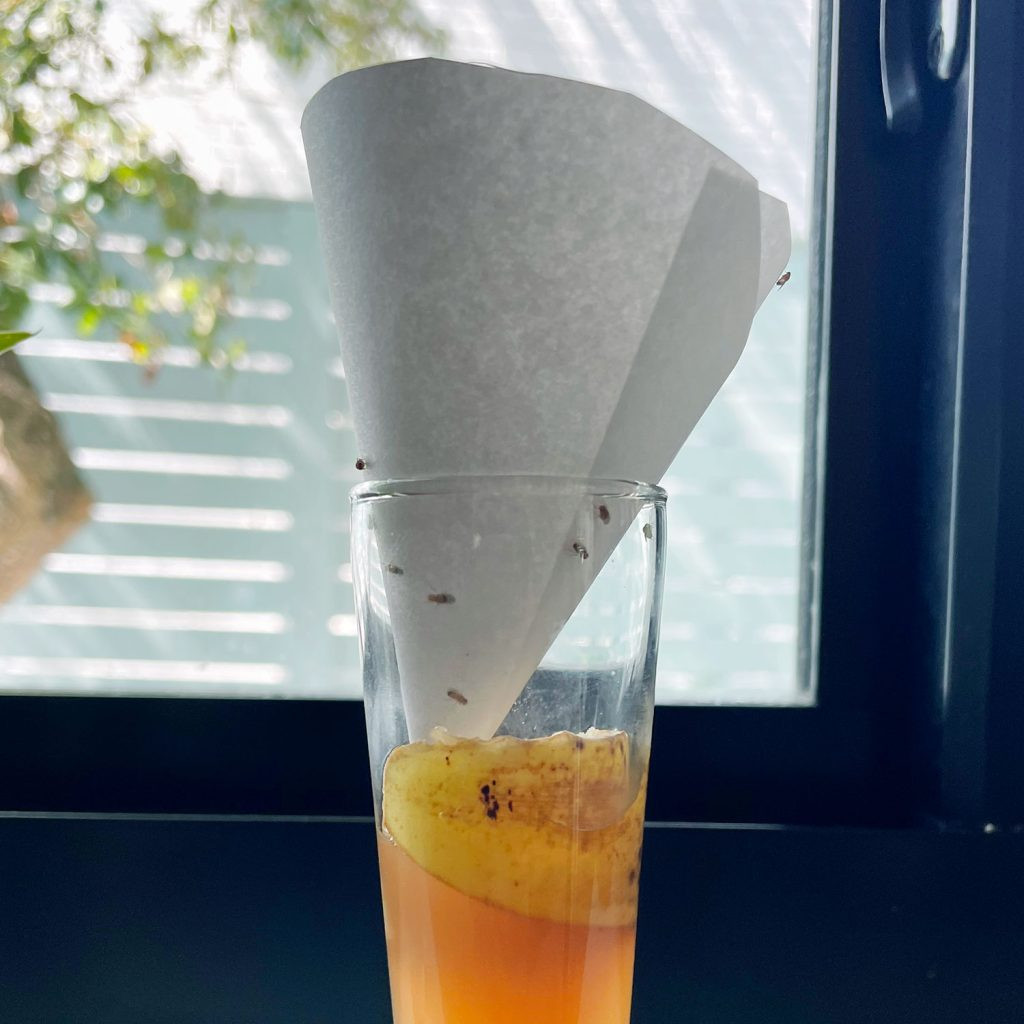 DIY Fruit Fly Trap With Paper Funnel
DIY Fruit Fly Trap With Paper Funnel
Alt text: Image showing a clear glass jar with a homemade paper funnel inserted into the opening, demonstrating the setup of a DIY fruit fly funnel trap using household materials.
Materials You’ll Need:
- A small, clear jar, cup, or container – ideally with a narrow opening to help prevent escape.
- A sheet of paper or cardstock – for creating the funnel.
- Tape – to secure the funnel shape.
- Scissors – for trimming the paper.
- Apple cider vinegar (ACV) – the primary attractant.
Step-by-Step Instructions:
- Select Your Container: Choose a small, transparent container such as a repurposed food jar or a plastic bottle. A narrow opening is beneficial for this method.
- Add Apple Cider Vinegar: Pour a small amount of apple cider vinegar, old beer, or wine into the bottom of the container. These liquids are excellent fruit fly attractants due to their fermented and fruity scents.
- Construct the Paper Funnel: Roll a piece of paper or cardstock into a cone shape, ensuring a very small opening at the pointed tip. Secure the cone shape with tape. You can trim the tip to create the small opening if it’s easier. The opening should be just large enough for a fruit fly to enter, about the size of a grain of rice.
- Position the Funnel: Place the paper funnel into the opening of your container, with the narrow tip pointing down towards the vinegar. You might need to adjust the funnel’s width so it rests securely on the rim of the container without touching the liquid. Ensure the funnel fits snugly against the edges of the container’s opening to prevent flies from escaping through any gaps.
- Humane Release Option (Optional): To release trapped fruit flies outdoors, carefully carry the entire trap outside, keeping the funnel in place to prevent escapes. Once outside, remove the funnel to allow the flies to fly away.
While commercially made funnels could be used, they often have openings that are too wide, which can reduce the trap’s effectiveness by allowing captured fruit flies to escape. Homemade paper funnels offer a more customizable and effective solution.
2. The Plastic Wrap Fruit Fly Trap
Similar to the funnel trap, the plastic wrap trap uses the enticing scent of apple cider vinegar to attract fruit flies. Flies enter through small holes poked in a plastic wrap cover but struggle to find their way back out.
Materials You’ll Need:
- A small, clear jar, cup, or container.
- A rubber band – to secure the plastic wrap.
- Plastic wrap or a plastic bag – to cover the container opening.
- A toothpick – to create small entry holes.
- Apple cider vinegar (ACV).
Step-by-Step Instructions:
- Choose Your Container: Select a small, clear jar, cup, or glass container. Clarity helps you monitor trap effectiveness, but opaque containers like old cans will also work.
- Pour in Apple Cider Vinegar: Add apple cider vinegar to the container. The smell is key to attracting fruit flies. Old beer or wine are effective alternatives, but avoid using regular white vinegar as it’s not as appealing to fruit flies.
- Cover with Plastic Wrap: Stretch plastic wrap tightly over the container’s opening and secure it firmly with a rubber band to create an airtight seal. Saran wrap works well, or you can repurpose pieces cut from a plastic bag.
- Poke Small Holes: Use a toothpick to carefully poke a few small holes in the plastic wrap covering. The holes need to be large enough for fruit flies to enter but small enough to discourage them from easily exiting. A few well-placed holes are sufficient.
- Humane Release Option (Optional): To release trapped flies, carefully take the trap outdoors without removing the plastic wrap. Once outside, remove the wrap to free the captured fruit flies.
Alternatively, you can adapt this method using a metal jar lid. Use a hammer and nail to puncture a small hole in a metal lid from a mason jar or food jar, creating a more durable and reusable trap cover.
3. The Dish Soap Fruit Fly Trap
This method differs from the previous two by eliminating the need for a cover. It relies on the principle of surface tension disruption using dish soap to trap fruit flies. Note: This trap is not designed for humane release, as the soap will coat and drown the flies.
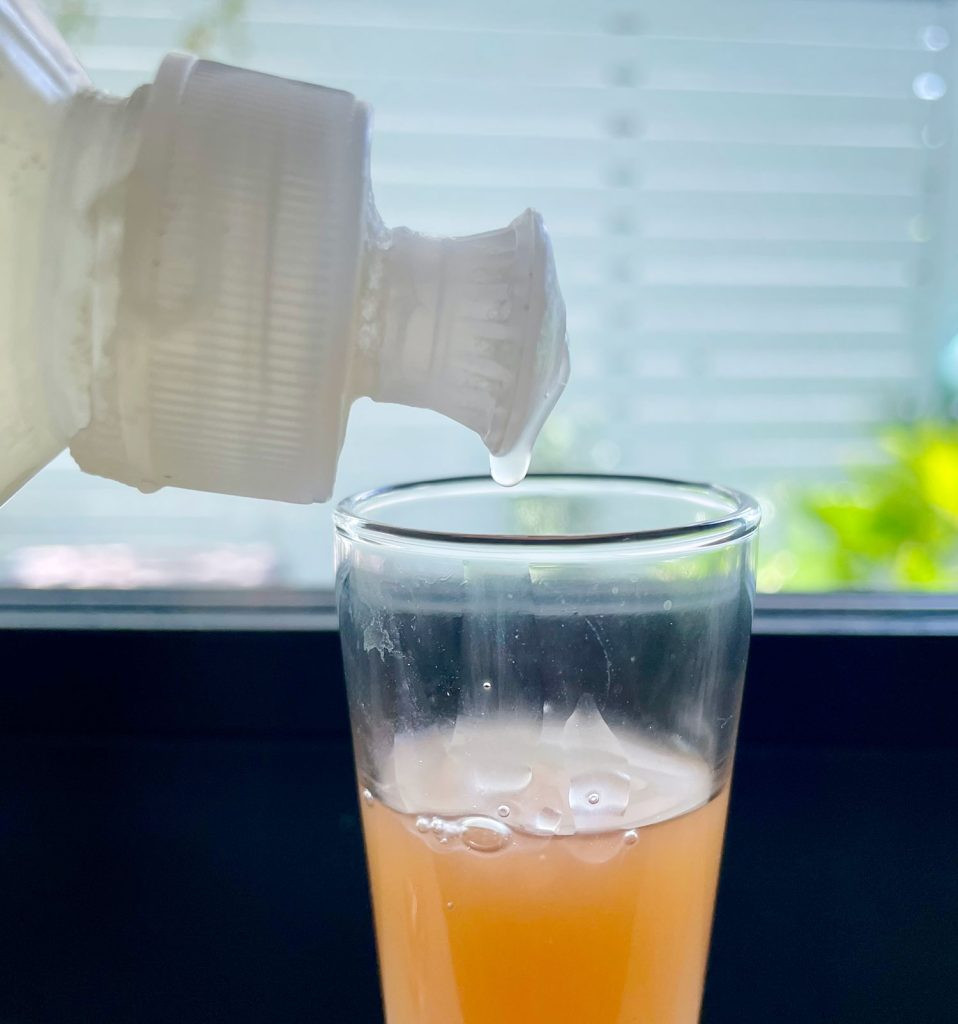 Dripping Dish Soap Into Apple Cider Vinegar For DIY Fruit Fly Trap
Dripping Dish Soap Into Apple Cider Vinegar For DIY Fruit Fly Trap
Alt text: A close-up shot of dish soap being squirted into a small bowl of apple cider vinegar, illustrating the simple preparation of a dish soap fruit fly trap solution.
Materials You’ll Need:
- A small container, bowl, or dish.
- Dish soap.
- Apple cider vinegar (ACV).
Simple Steps to Create the Trap:
- Pour Apple Cider Vinegar: Fill the bottom of a small container, bowl, or dish with apple cider vinegar. The scent acts as the primary attractant.
- Add Dish Soap and Mix: Add several drops of dish soap to the apple cider vinegar. Gently mix to combine. The soap reduces the surface tension of the vinegar, so when fruit flies land on the surface to investigate the scent, they will sink and become trapped instead of being able to fly away.
For enhanced effectiveness, you can combine this dish soap method with the plastic wrap or funnel trap. Simply add a few drops of dish soap to the apple cider vinegar before covering the container with plastic wrap or inserting the funnel. This provides an additional trapping mechanism.
4. The Rotting Fruit Bait Trap
This variation capitalizes on fruit flies’ strong attraction to overripe fruit. Instead of apple cider vinegar, this trap uses actual fruit as bait.
Materials You’ll Need:
- A small glass jar, cup, or container.
- Plastic wrap or paper funnel, depending on your preferred trap style.
- A small piece of overripe fruit, such as a banana peel or apple slice.
To create a rotting fruit trap, simply replace the apple cider vinegar in either the plastic wrap trap or funnel trap with a piece of banana peel, apple slice, or peach. You can also enhance the lure by adding a piece of fruit to apple cider vinegar. Be aware that fruit bait may need to be replaced every one to two days to prevent unpleasant odors in your kitchen and maintain its attractiveness to fruit flies.
Determining the Most Effective Fruit Fly Trap
To rigorously test these methods, I set up four different DIY traps to directly compare their performance. The four traps I tested were variations combining different techniques and baits:
- Plastic Wrap Trap with banana peel.
- Funnel Trap with ACV and banana peel.
- Plastic Wrap Trap with ACV and dish soap.
- Dish Soap Trap with ACV only.
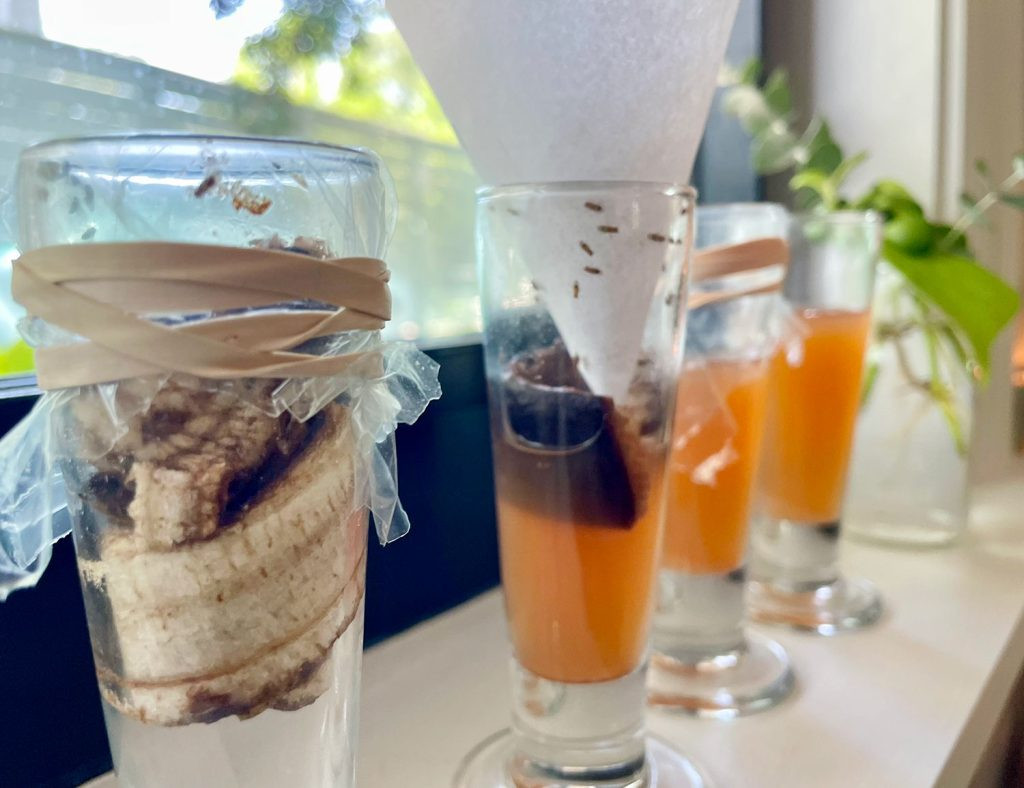 4 DIY Fruit Fly Traps Close Up
4 DIY Fruit Fly Traps Close Up
Alt text: A comparative photo showcasing four different DIY fruit fly traps lined up side-by-side, including plastic wrap traps and funnel traps, used in an experiment to determine the most effective design.
The results clearly indicated that the type of bait was more influential than the trap design. Traps baited with banana peel significantly outperformed those using only apple cider vinegar. While both plastic wrap traps were similarly constructed, the one containing banana peel captured dramatically more fruit flies than the ACV and soap trap. This suggests that while apple cider vinegar is effective, real fruit may be an even more irresistible attractant, especially when fresh fruit is readily available.
Based on these findings, I recommend incorporating a piece of fruit scrap into any DIY fruit fly trap you choose to set up. While both trap designs worked, I slightly preferred the plastic wrap trap for its ease of construction and stability. The funnel trap, while effective, was more prone to accidental tipping, which unfortunately released some trapped flies back into the kitchen during my experiment.
Identifying the Best Fruit Fly Bait
Intrigued by the superior performance of fruit scraps, I further investigated which type of fruit is the most effective bait. Using the plastic wrap trap design, I tested three readily available fruits side-by-side: banana peel, apple slices, and a strawberry. Each fruit was placed in a separate trap and set out on the countertop for 24 hours.
While the banana peel initially seemed promising due to its strong, ripe scent, the strawberry ultimately proved to be the most attractive bait. The banana peel did capture a good number of flies, but as the strawberry began to ferment slightly, it attracted an even greater number. Interestingly, the apple slices failed to attract any fruit flies during the test.
Store-Bought Fruit Fly Traps: An Alternative
If DIY traps aren’t effective enough for your situation, or if you prefer a ready-made solution, several commercially available fruit fly traps are on the market. These traps have generally positive reviews and are typically priced under $20. Store-bought traps may be a worthwhile option if you need something that targets a broader range of flying insects or if you prefer a more discreet trap design.
 Collage of Storebought Fruit Fly Traps
Collage of Storebought Fruit Fly Traps
Alt text: A collage displaying various store-bought fruit fly traps, showcasing different designs and brands available for purchase as alternatives to homemade traps.
During my experiment, I purchased a pack of Terro Fruit Fly Traps to compare their performance against my homemade traps. I placed a Terro trap alongside my banana and strawberry traps for 24 hours to assess which performed best.
Again, the homemade strawberry trap captured the most fruit flies, closely followed by the banana peel trap. The store-bought trap caught only a single fruit fly during this initial 24-hour period. However…
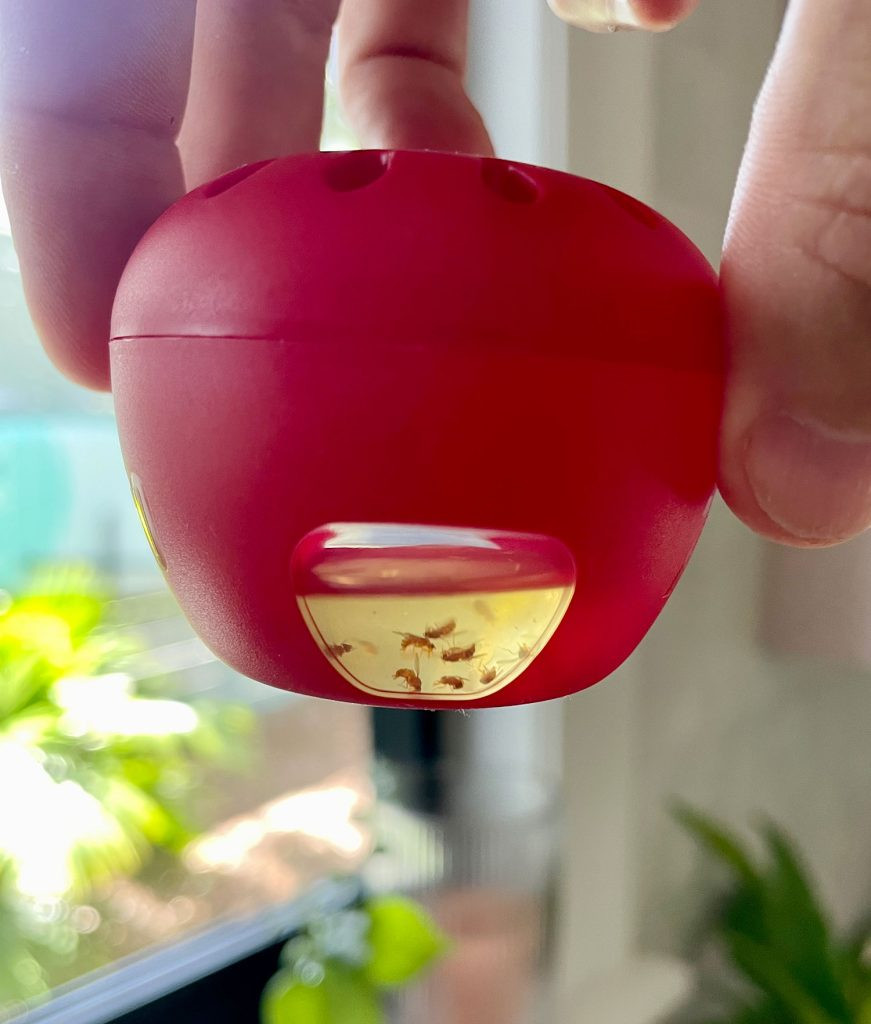 Terro Fruit Fly Trap With Dead Fruit Flies Visible
Terro Fruit Fly Trap With Dead Fruit Flies Visible
Alt text: A Terro brand store-bought fruit fly trap, visibly containing a collection of dead fruit flies inside the clear plastic housing, demonstrating its effectiveness over a longer period.
To ensure a fair comparison, I discarded the DIY traps and left the store-bought trap out for another 24 hours. Over this extended period, the Terro trap effectively caught a significant number of fruit flies, as shown in the image. So, while store-bought traps do work, they may not be as immediately effective as homemade traps, especially those baited with fresh fruit. My conclusion is that store-bought traps are a good option if you want a more aesthetically pleasing solution, particularly for long-term placement, but homemade traps offer a faster and often more effective way to quickly reduce fruit fly populations.
Preventing Fruit Fly Infestations: Proactive Measures
While eliminating fruit flies is relatively straightforward, preventing them from becoming a problem in the first place is even better. Here are simple preventative steps you can take to keep fruit flies out of your home:
- Maintain Clean Kitchen Surfaces: Regularly wipe down kitchen counters, stovetops, tables, and all surfaces prone to collecting food residue or spills. Fruit flies are particularly attracted to sugary and fermented substances, so promptly clean up any fruit juice, sugary drinks, or alcohol spills.
- Regularly Empty Trash Cans: Food scraps left in kitchen trash cans, especially overnight, can quickly become breeding grounds for fruit flies. Empty trash cans frequently, particularly those containing food waste.
- Dispose of Overripe Fruit Promptly: Monitor your fruit bowl and discard any fruit that is becoming overripe or showing signs of spoilage. Rotting fruit is a major attractant for fruit flies.
- Wash Produce Immediately After Purchase: Washing fruits and vegetables as soon as you bring them home from the grocery store can help remove any fruit fly eggs or larvae that may be present on the surface. (Note: Berries are best washed just before consumption to prevent premature spoilage due to moisture.)
- Refrigerate Produce When Possible: Fruit flies do not thrive in cold environments. Storing fruits and vegetables in the refrigerator, when appropriate, can significantly reduce their attractiveness to these pests.
- Keep Sink Drains Clean: Food particles and organic matter accumulating in sink drains can attract fruit flies. Regularly run your garbage disposal and flush drains with hot water and a cleaning solution to eliminate potential breeding sites.
Finally, remember that discovering fruit flies in your home is not a cause for panic. While prompt action is advisable to prevent a full infestation, the DIY and preventative solutions outlined here are easy to implement, effective, and fast-acting. You might even find yourself enjoying the process of experimenting with different fruit fly control methods, just as I did!
*This post contains affiliate links, so we may earn a small commission when you make a purchase through links on our site at no additional cost to you.